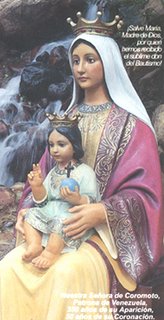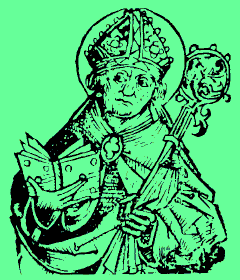
Our Lady of Coromoto
The Spaniards arrived at the region of Guanare, around 1591. The native Indians not wanting to have anything to do with the new settlers decided to move the tribe deeper into the forest and settled along the Tucupido River. The new settlers brought the Catholic religion to them but they refused to be converted. Fifty years passed and both groups lived in peace, the Coromoto Indians refusing to accept the Gospel that the Spaniards preached.
In 1651, the chief of the Coromotos and his wife see an extraordinary vision: in the ravine of the Tucupido River, upon the waters, a beautiful lady is looking at them with a loving expression on her face; the small child she carries also smiles amiably. The mysterious lady summons the Indian chief and orders him: "leave the forest with your people and go to the white men in order to receive the water on the head so as to be able to enter heaven".
The chief impressed by what he has seen and heard decides to obey the beautiful lady and leaves with his tribe to be schooled in the Christian religion by the Spaniards. The Indians being used to freedom find it very difficult to adjust to this new way of life. They leave after a short time and return to their village. The lady appears again, this time at the chief’s humble hut. Although the Virgin presents herself surrounded by a luminous aura whose rays fill the hut with fire, she does not succeed in moving the chief, who, annoyed, tries to throw her out and even takes his weapons in hand with the intention of threatening the inopportune lady. Smiling all the way, the Virgin approaches the chief gently and when he stretches out his hand angrily to catch her, she disappears before his eyes. A small holy card, where the image of the Lady was printed, was left in the Coromoto Indian's closed fist.
The Indians finally did what the lady asked of them being baptized and accepting the Catholic faith. This is how the Catholic faith was spread throughout Venezuela and today Venezuela is 95 % Catholic, the people having very devout devotions to Our Lady, especially to Our Lady of Coromoto.
The Virgin of Coromoto is a tiny relic that measures 27 millimeters high and 22 millimeters wide. The Virgin is painted seated, and on her lap sits the Child Jesus. It seems to have been drawn with a fine pen, sketched as a portrait done in Indian ink with dots and dashes. The Virgin and Child are looking straight ahead; their heads erect with royal crowns upon them. The back of the throne which supports them has two columns joined together by an arch. The Virgin's shoulders are covered by a crimson cloak with dark purple reflections, and a white veil falls symmetrically over her hair. She wears a straw colored tunic and the Child a white one. The image is kept inside a richly adorned monstrance where it is presented for the veneration of the faithful.
At the request of the nation's bishops, on October 7, 1944 Pius XII declared her "Patroness of the Republic of Venezuela" and her canonical coronation was celebrated on the third centenary of her apparition, on September 11, 1952. His Eminence Cardinal Manuel Arteaga Betancourt, Archbishop of Havana, representing Pope Pius XII, crowned the sacred image of Our Lady of Coromoto. The Venezuelans celebrate their patroness each year on three different occasions: February 2 and September 8 and 11. The National Sanctuary of the Virgin of Coromoto, a meeting place of great pilgrimages, was declared a Basilica by Pope Pius XII on May 24, 1949.

